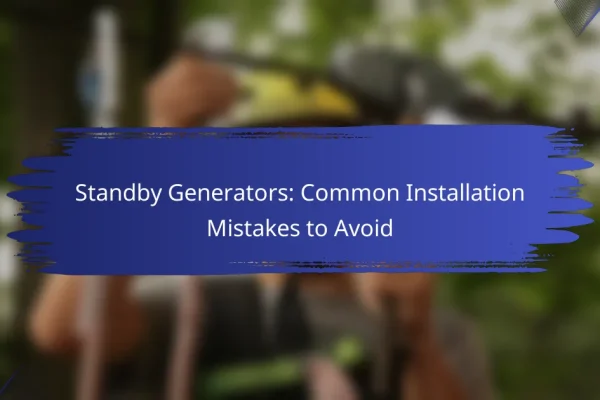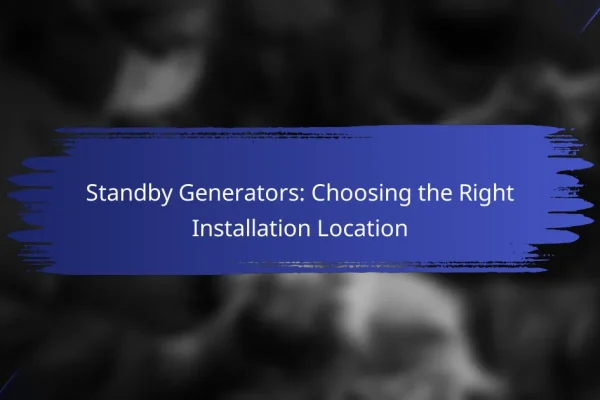What is the standby generator installation process?
The standby generator installation process involves several key steps to ensure that the generator is properly set up and operational. This typically includes site assessment, obtaining necessary permits, installing the generator unit, making electrical connections, and conducting testing to confirm functionality.
Site assessment and planning
The first step in the installation process is a thorough site assessment. This involves evaluating the location for the generator, considering factors such as accessibility, proximity to the main electrical panel, and local zoning regulations.
Planning should also include determining the appropriate generator size based on the power needs of the home or business. A qualified technician can help calculate the required wattage to ensure the generator can handle the load during an outage.
Permitting and regulations
Before installation, it is essential to secure the necessary permits from local authorities. Regulations can vary significantly by region, so checking with local building departments is crucial to ensure compliance with safety codes and zoning laws.
Some areas may have specific requirements regarding the placement of generators, such as distance from property lines or ventilation needs. Failing to adhere to these regulations can result in fines or the need for costly modifications.
Installation of the generator unit
The installation of the generator unit typically involves positioning the generator on a stable, level surface, often on a concrete pad. This ensures proper drainage and stability during operation.
It is important to follow the manufacturer’s guidelines during installation, which may include securing the unit to prevent movement and ensuring adequate clearance for maintenance and ventilation. Professional installation is recommended to avoid common pitfalls.
Electrical connections and setup
Once the generator is in place, the next step is to make the electrical connections. This involves linking the generator to the electrical panel and ensuring that the transfer switch is properly installed to manage power flow during an outage.
Electrical work should always be performed by a licensed electrician to ensure safety and compliance with local codes. Properly configured connections will prevent backfeeding into the grid, which can pose serious hazards.
Testing and commissioning
The final step in the installation process is testing and commissioning the generator. This involves running the generator to verify that it operates correctly under load conditions and that all safety features are functioning.
Regular maintenance checks and testing should be scheduled to ensure the generator remains in good working condition. This may include routine inspections and servicing to address any potential issues before they arise.
What are the key steps in installing a standby generator?
The installation of a standby generator involves several critical steps to ensure proper functionality and safety. Key steps include selecting the appropriate generator size, preparing the installation site, installing a transfer switch, and connecting the fuel supply.
Step 1: Choose the right generator size
Choosing the right generator size is essential for meeting your power needs during outages. Consider your home’s total wattage requirements, including essential appliances and systems, to determine the appropriate generator capacity, typically measured in kilowatts (kW).
A common guideline is to select a generator that can handle at least 20-30% more than your calculated wattage to accommodate potential surges in power demand. For example, if your essential load is around 5 kW, a generator rated between 6-8 kW would be suitable.
Step 2: Prepare the installation site
Preparing the installation site involves ensuring adequate space and proper conditions for the generator. The location should be level, well-ventilated, and away from windows or doors to prevent exhaust fumes from entering your home.
Check local regulations for any specific requirements regarding distances from structures and property lines. Typically, a clearance of at least 5 feet from walls and other obstructions is recommended.
Step 3: Install transfer switch
The transfer switch is a crucial component that safely connects your generator to your home’s electrical system. It prevents backfeeding into the grid, which can pose serious safety risks.
Installation should be performed by a qualified electrician to ensure compliance with local electrical codes. The transfer switch should be located near your main electrical panel for easy access and efficient wiring.
Step 4: Connect fuel supply
Connecting the fuel supply is necessary for the generator to operate. Depending on the type of generator, this could involve natural gas, propane, or diesel. Ensure that the fuel lines are properly installed and leak-tested.
For natural gas or propane generators, consult with a licensed gas technician to ensure safe and compliant connections. If using diesel, ensure you have a suitable storage tank that meets local regulations.
What permits are required for generator installation in California?
In California, installing a standby generator typically requires several permits to ensure compliance with local regulations. The main permits include building, electrical, and gas line permits, each serving a specific purpose in the installation process.
Building permits
Building permits are essential for any structural modifications or installations, including standby generators. These permits ensure that the installation meets local building codes and safety standards.
To obtain a building permit, you will need to submit plans detailing the generator’s location and installation method. It’s advisable to check with your local building department for specific requirements and fees, which can vary widely across different jurisdictions.
Electrical permits
Electrical permits are required for any work involving the generator’s electrical connections. This permit ensures that the installation complies with the National Electrical Code (NEC) and local electrical regulations.
When applying for an electrical permit, you may need to provide documentation of the generator’s specifications and the planned electrical work. Hiring a licensed electrician can help streamline this process and ensure compliance with safety standards.
Gas line permits
If your standby generator runs on natural gas or propane, a gas line permit is necessary. This permit verifies that the gas line installation adheres to safety codes and regulations.
Obtaining a gas line permit typically involves inspections and may require a licensed contractor to perform the installation. Be sure to check local regulations, as requirements can differ significantly based on your location within California.
How to choose a standby generator installation service?
Selecting a reliable standby generator installation service involves assessing their qualifications, reputation, and pricing. Focus on licensed professionals with positive customer feedback and transparent quotes to ensure quality work and peace of mind.
Check for licensing and insurance
When choosing a standby generator installation service, verify that they hold the necessary licenses and insurance. Licensed contractors are typically required to meet specific standards, ensuring they are qualified for the job.
Insurance protects both you and the contractor in case of accidents or damages during installation. Request proof of these credentials before making a decision.
Read customer reviews
Customer reviews provide insight into the reliability and quality of an installation service. Look for feedback on platforms like Google, Yelp, or specialized home improvement sites.
Pay attention to recurring themes in reviews, such as punctuality, professionalism, and post-installation support. A service with consistently positive reviews is more likely to meet your expectations.
Request detailed quotes
Obtain detailed quotes from multiple installation services to compare pricing and services offered. A comprehensive quote should outline labor costs, materials, and any additional fees.
Beware of quotes that seem significantly lower than others, as they may indicate subpar materials or hidden costs. Aim for transparency and clarity to avoid surprises later on.
What are the costs associated with standby generator installation?
The costs associated with standby generator installation can vary significantly based on several factors, including the generator’s size, installation complexity, and local labor rates. Generally, homeowners should expect to invest several thousand dollars for a complete installation, including the generator unit and necessary electrical work.
Average installation costs
The average installation costs for a standby generator typically range from $3,000 to $7,000 in the United States. This estimate includes the generator itself, which can cost between $2,000 and $5,000, along with installation labor and materials. Prices may be higher in urban areas or regions with a higher cost of living.
Factors affecting pricing
<pSeveral factors can influence the overall pricing of standby generator installation. The generator's capacity, measured in kilowatts, is a primary determinant; larger units capable of powering more appliances will generally cost more. Installation complexity, such as the need for additional electrical work or permits, can also add to the total expense.
Local regulations and codes may require specific types of installations or additional safety features, impacting costs. Additionally, the choice between a natural gas or propane generator can affect pricing, as fuel type availability and installation requirements differ.
Maintenance costs post-installation
<pAfter installation, maintenance costs for a standby generator typically range from $100 to $300 annually. Regular maintenance is essential to ensure the generator operates efficiently and reliably during power outages. This may include oil changes, filter replacements, and system checks.
<pHomeowners should also consider the potential costs of repairs, which can vary based on the generator's brand and age. Investing in a service plan with a qualified technician can help manage these expenses and ensure timely maintenance.
What are common issues during standby generator installation?
Common issues during standby generator installation include improper sizing, inadequate location selection, and failure to comply with local regulations. These problems can lead to inefficient operation, safety hazards, and costly adjustments after installation.
Improper sizing of the generator
Choosing the wrong size generator is a frequent mistake. An undersized generator may struggle to power essential appliances during an outage, while an oversized unit can lead to increased fuel consumption and higher operational costs. It’s crucial to calculate your power needs accurately, considering both starting and running wattages of your devices.
To determine the appropriate size, list all appliances and their wattage requirements. A common guideline is to add up the starting wattages and multiply by a safety factor, typically around 1.25, to ensure adequate capacity.
Inadequate location selection
Installing a generator in an unsuitable location can cause several issues, including noise complaints and safety hazards. Generators should be placed outdoors, away from windows and doors, to minimize noise and exhaust exposure. Additionally, ensure there is adequate ventilation and space for maintenance access.
Consider local zoning laws and regulations when selecting a location. Some areas have specific requirements regarding the distance from property lines and structures, which can affect where you can install your generator.
Failure to comply with local regulations
Not adhering to local codes and regulations can lead to fines and safety risks. Many jurisdictions require permits for generator installation, and failure to obtain these can result in legal complications. It’s essential to consult local building codes and regulations before proceeding with installation.
Working with a licensed electrician familiar with local requirements can help ensure compliance. They can guide you through the permitting process and ensure that the installation meets all safety standards, reducing the risk of future issues.












